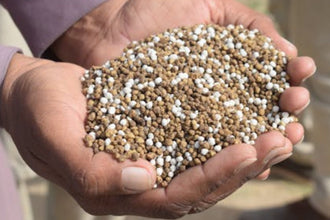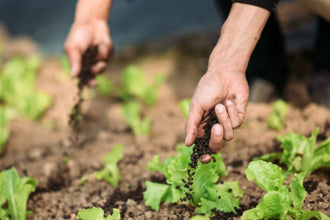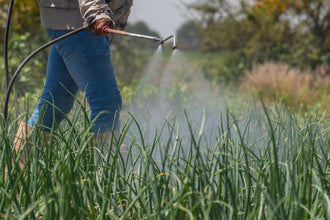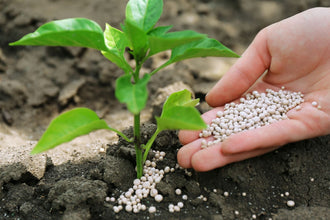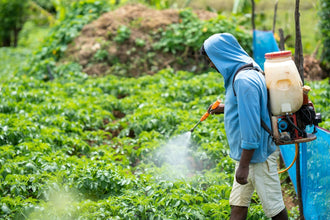Organic farming is a method of agriculture that excludes the use of synthetic inputs. Instead, it focuses on enhancing the natural fertility of soil, recognizing its crucial role in growing healthy, nutrient-rich crops.
Soil fertility is the foundation of organic farming - it supports the diverse life within the soil, sustains agricultural productivity, and helps conserve our environment. Thus, understanding and maintaining soil fertility is indispensable.
It not only helps to preserve ecosystems by fostering soil biodiversity, but it also underpins sustainable agriculture, promoting healthy crop growth and eventually contributing to food security. In short, it is a cornerstone for the longevity of our farm ecosystems and the productivity of our food systems.
The Role of Soil in Organic Farming
Soil plays an indispensable role in organic farming, serving as the foundation for growing healthy and sustainable crops without synthetic additives.
Composition of Fertile Soil
The fertility of soil lies not just in its inorganic components, but also in its teeming, intricate ecosystems. These ecosystems consist of countless microorganisms, insects, and other soil lifeforms that actively work to decompose organic matter and minerals. The outputs of this decomposition are crucial nutrients that plants require for healthy growth. Key components of a fertile soil include:
- A rich presence of essential nutrients such as nitrogen, phosphorus, and potassium, along with trace elements.
- A well balanced pH level, imperative to the absorption of nutrients by plants.
- A substantial amount of humus, the organic matter in soil. Humus holds moisture and nutrients, buffers soil against pH changes, and harbors a healthy community of soil life. This effectively reduces the need for outside inputs like chemical fertilizers.
How Soil Type Affects Crop Growth
The type of soil in a farming field is as significant a determinant of crop success as the farmer's expertise or the quality of crop varieties. Each soil type possesses unique properties, which can greatly affect the growth and success of crops. Here's how different soil types can influence:
- Sandy Soil: Characterized by larger particle sizes, sandy soil offers great aeration and quicker drainage. This makes it suitable for crops that don't require excessive moisture.
- Clayey Soil: Consisting of smaller particles, clayey soil excels in holding water and nutrients. However, it could pose issues with drainage and aeration.
- Loamy Soil: Often deemed the best for most crops, loamy soil provides the best of both worlds. It boasts a balanced blend of sand, silt, and clay, offering optimum moisture, nutrient content, and aeration.
Understanding the soil type is therefore vital to select appropriate crops and employ effective farming practices, ensuring bountiful and healthy harvests.
Maintaining Soil Fertility in Organic Farming
Maintaining and enhancing soil fertility in organic farming require nature-based and sustainable agricultural strategies. Applying such methods helps reduce the negative environmental impact and contributes to improved farm productivity. Here are various strategies used in organic farming to maintain soil fertility:
Using Organic Composts
Organic compost is a critical aspect of organic farming which serves as a natural, nutrient-rich soil amendement.
- Role of Organic Compost: Organic compost helps to replenish soil nutrients, improve soil structure, and promote healthy root development. It provides a wide range of macro and micro nutrients that are slowly released into the soil, making it an excellent alternative to synthetic fertilizers.
- Improving Soil Fertility: By adding organic compost to the soil, its fertility can be considerably improved. This is because compost improves soil aeration, water retention and fosters the growth of beneficial soil microorganisms, thereby boosting soil productivity.
Implementing Crop Rotation
Crop rotation is a time-tested, traditional method of preserving and enhancing soil fertility.
- The Concept of Crop Rotation: This entails the systematic planting of different crop types in a sequential manner in the same plot of land over different seasons. It is aimed at optimizing the use of nutrients and breaking the cycle of pests and diseases.
- Why Essential in Organic Farming: Crop rotation is an essential practice in organic farming as it reduces soil erosion, maintains soil organic matter and nutrient balance, disrupts the life cycle of pests, and diversifies farm income.
Encouraging Beneficial Soil Organisms
Encouraging a biodiverse population of soil microorganisms plays a vital role in maintaining soil fertility.
- Role of Soil Organisms: Beneficial soil organisms, including bacteria, fungi, and earthworms, help to break down organic matter, freeing up nutrients for plant uptake. They enhance soil structure and fertility by creating soil aggregates.
- Promoting Soil Organism Activity: Activities such as addition of organic matter through composting, minimizing tilling, and maintaining proper soil pH can promote the activity of these soil organisms.
By ensuring the use of these methods, organic farming not only maintains but also improves the vitality and fertility of the soil, leading to a more sustainable and productive agricultural system.
Challenges in Maintaining Soil Fertility
Just as important as understanding the methods to preserve soil fertility, it's also crucial to be aware of the challenges faced in maintaining the same. Let's delve into these obstacles:
External Threats to Soil Fertility
Various external threats can significantly undermine efforts to maintain and enhance soil fertility.
- Impact of Climatic Changes: Changes in climate result in unpredictable precipitation and weather patterns, which may intensify soil erosion, nutrient leaching, and create unfavorable conditions for microbial activity, all leading to decreased soil fertility.
- Pests and Diseases: Pests and diseases can proliferate in certain crop rotation systems leading to a loss in crop yield and a decline in soil fertility.
- Over-cultivation: Over-cultivation or intensive farming can exhaust soil nutrients, disrupt the native soil biota and degrade the soil structure, thus leading to decreased soil fertility.
- Pollution: Pollution from various sources like industrial activities or incorrect disposal of waste can lead to the accumulation of toxic elements in the soil, altering soil chemistry and making it less inhabitable for beneficial soil organisms.
Increasing Costs and Time Investment
Implementing the practices for maintaining soil fertility in organic farming can be more demanding in terms of both time and money when compared to conventional farming methods.
- Increased Operational Costs: The procurement of quality organic compost or the cost involved in preparing it, implementing diverse crop rotations, and other organic farming techniques can add significantly to the operational costs.
- Greater Time Requirement: Organic farming methods like composting, cover cropping, mulching, and crop rotation require more meticulous planning and greater time investment than conventional farming methods. The process of composting alone can take several months, while establishing effective crop rotation systems takes careful short and long-term planning.
While these challenges need to be understood and addressed, it's also essential to reiterate that the benefits of maintaining soil fertility reach beyond immediate economic returns. It can greatly contribute to long-term agricultural sustainability, food security, and environmental conservation. As such, seeking innovative, cost-effective solutions to these challenges becomes an essential part of contemporary organic farming.
Impacts of Proper Soil Fertility Maintenance
Proper soil fertility management most directly affects the farmers and growers who depend on the soil productivity. Yet, it carries considerable benefits not just for them, but also for the environment and society at large. Let's delve into some of the significant impacts.
Yield Improvement
Being able to produce high yields consistently is critical to the economic well-being of farmers.
- Direct correlation: There is a direct relationship between healthy, nutrient-rich soil, and high crop yields. Soil that has been managed well in terms of fertility tends to have a balanced nutrient content, good soil structure, and sufficient organic matter – all essential to producing an abundant harvest.
- Sustainable Productivity: With proper soil fertility management, the land can continue to provide high yields over the long term. Unlike farming methods that rely on synthetic fertilizers, healthy soil fertility practices support continuous productivity and do not degrade the soil's nutrient content over time.
Crop Health and Resilience
Soil fertility does more than just improve the overall yield; it affects the health and resilience of the crops grown in the soil.
- Increased Nutrient Uptake: Nutrient-rich, well-managed soil facilitates a higher nutrient uptake by crops, contributing to healthier growth, enhanced crop quality, and better nutritional value of the final produce.
- Resilience to Pests and Diseases: Healthy plants grown in fertile soils resist pests and diseases better, reducing the dependency on chemical pesticides.
- Climate Resilience: By maintaining a robust soil ecosystem through organic matter and diverse microbiological activity, farms could fare better amidst erratic weather patterns caused by climate change. Such soils are more effective at water retention, reducing the risk of crop failure in drought conditions, and minimizing water logging during excessive rainfall.
By investing time and resources into proper soil fertility management, farmers and gardeners could enjoy improved yields and healthier crops that stand up better against disease, pests, and climate fluctuations. Additionally, they contribute positively to the broader environment, making agricultural systems more sustainable in the face of escalating global challenges.
Conclusion
Organic farming presents a holistic approach to agriculture, harmonizing with nature while ensuring high productivity. The heart of this approach lies in maintaining and enhancing soil fertility, a vital facet of agricultural sustainability. While the practice comes with its challenges, such as increased costs, time investment, and threats from external factors, the benefits are manifold.
Through methods like organic composting, crop rotation, and fostering a diverse soil biota, organic farms can ensure the long-term productivity of the soil, yielding healthier, more resilient crops. Resultantly, these practices offer economic benefits for farmers, food security for society, and a healthier environment for us all.




